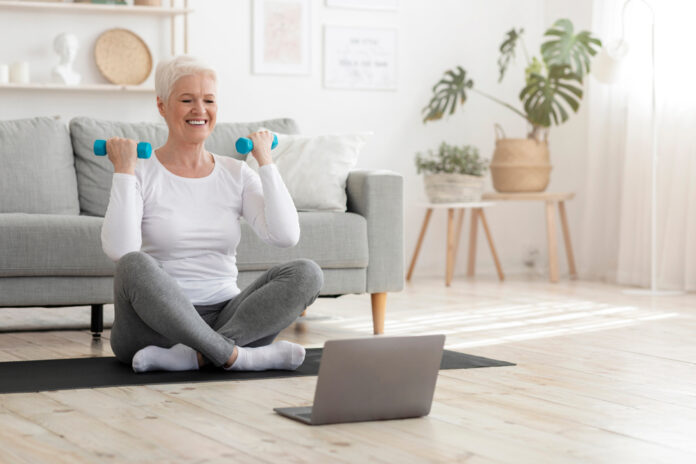Wondering, “Why is it important for elderly to stay active?” The importance of exercise for seniors cannot be overstated, since physical activity can prevent deterioration due to aging.
Staying active is key to quality of life, and can even help prevent falls and fractures. Keep reading for answers to common questions about exercise for seniors.
Why Is Physical Activity Important for Older Adults?
Exercise improves health in many ways. From endurance to balance exercises, physical activity can help prevent falls, strengthen muscles, and increase flexibility.
Interestingly, physical activity has benefits beyond the physical. Mental health can also be improved since exercise prompts the body to release feel-good chemicals called endorphins.
Since inactivity can lead to losing abilities, adding workouts to your routine is wise for wellness. Luckily, a doctor and other health professionals can help provide guidance to help get you moving. Specialists like physical therapists can also help you if you’re worried about safety.
Physical Benefits of Staying Active
Moving your body has many health benefits, ranging from a short-term boost in mood to long-term disease prevention. Discover the following benefits through daily exercise.
Contribute to Heart Health
Physical activity assists the body in combating high blood pressure. Exercise also conditions the body, making the heart, muscles, and other organs more comfortable with higher activity levels. It may sound counterintuitive, but active older adults tend to be less fatigued.
Improve Balance, Mobility, and Strength
Improving balance prevents falls, and can reduce the risk of falling. Since working out also builds strength and muscle mass, bone density scores can improve, too. As a result, strong muscles and bones can create a strong body, capable of accomplishing daily tasks easily.
In other words, exercise can greatly influence the quality of life through improved balance, mobility, and strength.
Encourage Independence and Longevity
Staying active can also help you stay independent. Following a regular exercise prescription can be considered preventative, meaning it may stave off the development of serious diseases. It can also encourage independent living with age if that is your priority.
Lower Risk of Chronic Conditions
Research supports exercise for many chronic conditions, especially those associated with age. For example, moving your body each day can be a vital part of preventing (or managing) the following conditions:
- Arthritis
- Certain cancers
- Heart disease
- Osteoporosis
- Stroke
- Type 2 diabetes
Mental and Cognitive Benefits of Staying Active
Curious about the cognitive benefits of exercise? You’ll benefit mentally from making movement part of your daily routine.
Enhance Mood
Research has shown that exercise can reduce the amount of stress, anxiety, or depression an individual is experiencing. As mentioned above, exercise causes an increase in chemicals that make your mind feel happy. This can be crucial to maintaining a good mood, despite difficult life circumstances.
Better Manage Periods of Mental Illness
Emotionally, exercise is a good choice. Especially during periods of mental illness, physical activity can be crucial to providing a healthy emotional outlet. Physical strength can also make you feel mentally strong.
Plus, many types of exercise take you outside in nature, which can also improve mood. For example, walking can be a sort of meditative experience, and meditation is known to benefit emotional wellness. Working out with a friend also provides an opportunity for socialization and connection, which some seniors lack.
Improve General Wellbeing
Like other organs, the brain also benefits from physical activity. Studies show that working out regularly may improve some aspects of cognitive functioning. In other words, prioritizing the movement you enjoy may boost the parts of the brain controlling task or priority management, organization, and memory.
How to Promote Physical Activities in Older Adults
Don’t know where to start? The following tips can help you incorporate physical fitness into your wellness routine.
Have A Clear Goal In Mind
In general, it’s recommended that older adults get at least 150 minutes of moderately intense physical activity each week. This works out to about 30 minutes of daily activity for most people. If you like more intense activities, 75 minutes may be sufficient.
Picking strength training activities at least two days a week is efficient for building, strengthening, and maintaining muscles. Keep in mind that strength training isn’t only weights. For example, practicing yoga for 30 minutes may be more gentle on your joints while still building strength.
Also, try and keep your motivation top of mind! This can help when you feel unmotivated or stuck. Some people find picturing playing with their grandkids easily to be incredibly motivating, making the process’s difficult parts worth it.
Explore Different Forms
An exercise routine doesn’t need to be the same list of activities every day. Feel free to switch it up! For example, try aerobic exercise (like walking or swimming) one day, and strength training (such as lifting weights or yoga) another day.
Start Small and Work Your Way Up
When engaging in exercise, you don’t have to go “all in” right away. Walking to the mailbox, for example, can be sufficient to increase circulation momentarily and provide marginal benefits to heart health.
Over time, increase the amount you walk each day. Slow progress can be more sustainable in the long run, and be especially apt if you’re recovering from seasonal illness or an injury.
Other tips for increasing exercise gradually include:
- Count more intense chores or outdoor tasks (like gardening) as exercise
- Stretching
- Warm-ups (or warm-downs)
Make It More Social
Your exercise hour can also count as a social hour! For example, walking with a friend can make the time more meaningful. Plus, you’ll technically burn more calories by talking and gesturing.
Many senior centers, care facilities, and workplaces also provide exercise programs. If you can’t afford one-on-one physical therapy, these resources can provide valuable guidance and structure to your daily fitness routine.
Work With an Exercise Expert
Working with an exercise expert can help you identify barriers along the way. It can also help you perform tricky moves or exercises properly, reducing the risk of injury from physical activity. Involving an expert or asking for an exercise prescription can provide you with the proper guidance you need to make progress.
In Summary on the Importance of Exercise for Seniors
No matter where you are on your fitness journey, it’s never too late to improve your physical and mental health. From making connections with workout friends to working with an expert, you don’t have to be alone in your efforts. Remember to start small, enforce safety measures, and reach optimal strength levels.
References:
Mayo Clinic Staff. Exercise and stress: Get moving to manage stress. Mayoclinic.org. Published August 2022.
National Institute on Aging. How Older Adults Can Get Started With Exercise. Nia.nih.gov. Published April 2020.
National Institute on Aging. Mental Health Benefits of Exercise and Physical Activity. Nia.nih.gov. Accessed June 2023.
National Institute on Aging. Real-Life Benefits of Exercise and Physical Activity. Nia.nih.gov. Published April 2020.
National Library of Medicine. Exercise for Older Adults. Medlineplus.gov. Published March 2015.
Zaleski AL, Taylor BA, Panza GA, Wu Y, Pescatello LS, Thompson PD, Fernandez AB. Coming of Age: Considerations in the Prescription of Exercise for Older Adults. Methodist Debakey Cardiovasc J. 2016;12(2):98-104.






